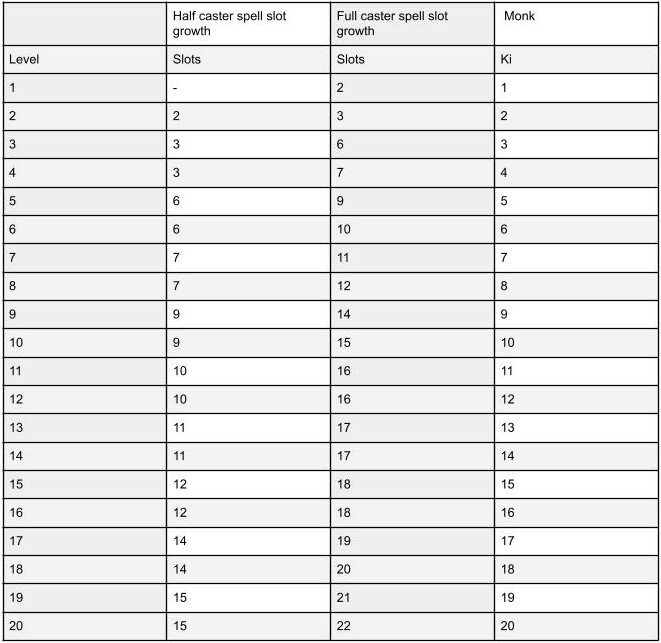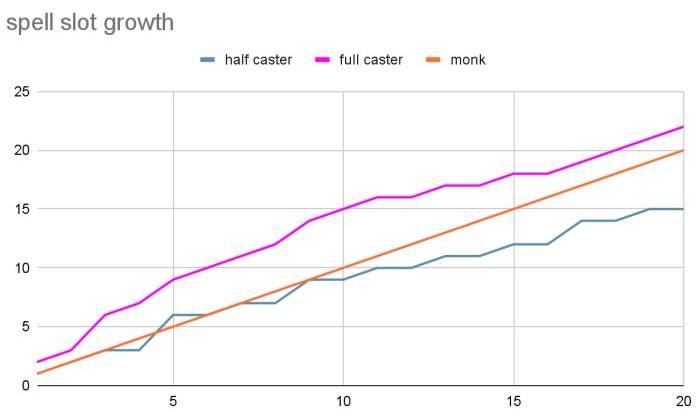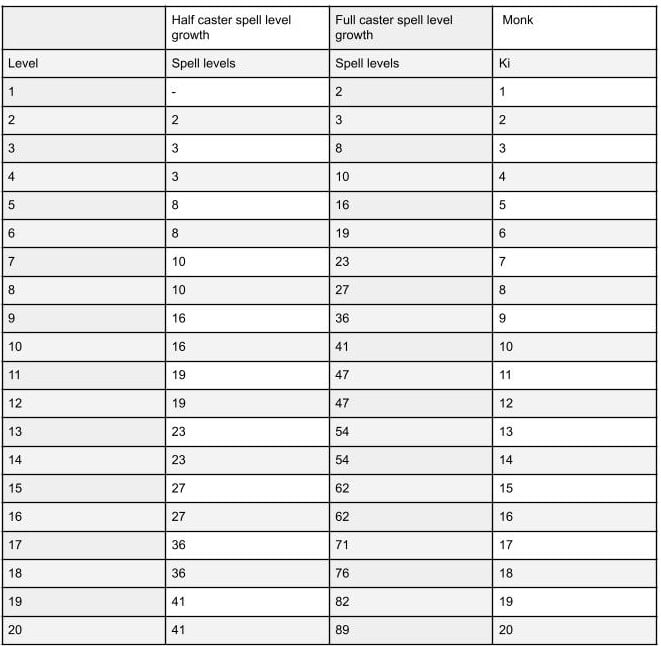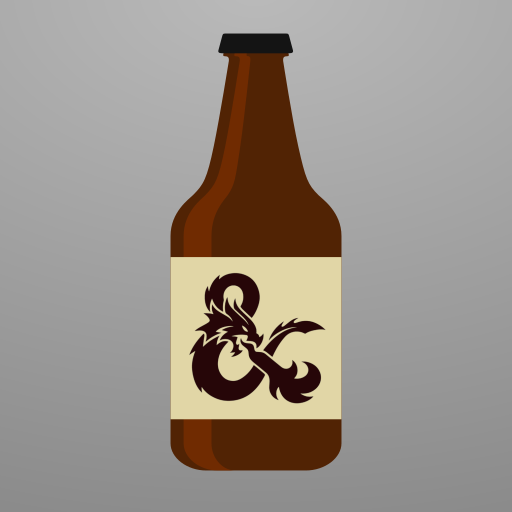Introduction
When homebrewing, it is important to understand the values of the game resources both, for creating new ways to use them such as new spells, and for creating new resources as part of; subclasses, magic items, or new classes.
If you don’t care to read this whole discussion, the value of 1 ki is equal to one spell level in 9 out of 10 cases as shown by comparing ki abilities with spells. But that’s not all we will be discussing here, in addition we will look at how ki progression compares to spell progression of half and full casters.
side note: I have looked at the value of a ki point before and came to the same conclusion. But I thought I would do more comparisons to casters this time since I often hear a monk compared to a half caster and this comparison has been used to create full caster psionic classes.
base class comparisons
- Flurry of blows
Value: 1st level spell slot
comparison notes
At level one we can expect this ability to be dealing around 2d4+6 damage. without calculating for accuracy that’s an average of 12 damage, compared to the DMGs spell creation guide a first level spell should be dealing 2d10 damage (average 12). While this ability does require the use of your bonus action which would be a value increase it is offset slightly by the requirement that it is used on the same turn as the attack action.
- Patient defense
Value: <1st level spell slot
comparison notes
While this is a powerful ability, when compared to the defensive capability one can get with a 1st level spell slot this pales. For this we are comparing it to the shield spell. Patient defense is used as a bonus action and not a reaction making it less valuable, additionally we can calculate the average roll adjustment by disadvantage as about 3.4 (this article does a good job of explaining). Of course 3 is less than 5 making this ability absolutely not worth a 1st level spell slot
- Step of the wind
Value: 1st level spell slot
comparison notes
Escaping from a melee is highly valuable to characters with low health, it’s one reason misty step is a common ‘must have’ spell. While this ability can’t get you as far and has less overall functionality, that should be expected since misty step is a 2nd level spell. If you have allies you can position yourself around so pursuers provoke opportunity attacks then this is definitely worth it.
- Quickened healing
Value: 1st level spell slot
comparison notes
Since this is a simple healing spell we can compare it directly to cure wounds. At 4th level this heals 1d4+2 (average 5) versus cure wounds that we can expect to heal 1d8+2 or +3 (average 8 or 9). With the lower healing and the inability to target allies, why would I place this as a value of 1st level spell slot? Because it scales to 1d6+3 the very next level to an average of 7 and continues to scale after that.
- Focused aim
Value: 1 ki to 1 spell level
comparison notes
This ones a little tough. Increasing your attack roll by 2 is statistically going to increase your damage for the attack by 10% by increasing your accuracy. For comparison spells that increase your accuracy are… true strike… Well, we will compare it anyway. This ability is made less valuable by comparison because true strike increases your attack roll by 3.4 (I’ll direct you to this article again) and also this ability requires resources. However this ability is made more valuable by; not requiring an action, by being usable after you know the result of your attack, and not needing to use it the turn before you intend to attack. Overall I’d say the positives outweigh the negatives enough for this to be worth it. I’d say that in a vacuum this is in my opinion slightly less valuable than divine smite.
- Diamond soul
Value: 1st level spell slot
comparison notes
For the comparison we will use silvery barbs. This ability is made less powerful than silvery barbs by; only affecting saving throws, and not also having a second effect. It is made significantly more powerful by not requiring a reaction.
- Empty body effect one
Value: indeterminate. I would feel very good using a 4th level spell slot on this however, it is powerful.
- Empty body effect two
Value: depends
comparison notes
It is still the full effect of the 9th level spell, just with seven less targets. It is only really useful if the DM allows it to be useful and is prepared to handle the spell, which is harder to do when only one member of the party is astral projecting.
Subclass comparisons
To not cause these comparisons to overstay their welcome I’m only going to point out monk subclasses with casting
- Way of shadow
The way of shadow subclass can cast four different 2nd level spells from 3rd level, on a 1 ki to 1 spell level rate. This casting is actually a faster progression than half casters have and as fast as a full caster. However the progression is flat as those are the only spells they can cast and they cannot upcast them.
- Sun soul
The sun soul has, at 6th level the ability to cast burning hands, a 1st level spell for a 1 + 1 ki per spell level cost. The fact that it is being cast as a bonus action is likely the cause for this 1 ki tax. You might note that with 1 ki placed at one 1st level spell slot of value it is worth 2 sorcery points, enough to use quickened spell metamagic. The only other observation I will make is that it’s a bit late to be getting a 1st level spell.
- Four elements
For some reason the monk of four elements is really bad at doing the one thing it’s supposed to do, with the redeeming feature of having spell progression of a half caster as a subclass. Every spell has a 1 ki point tax applied.
Spell slot growth comparisons
These numbers will be presented in both charts and graphs. When looking at these numbers it is important to note that spell slots, with some exceptions, recover at long rests and not short rests like ki points.
Below is a chart and graph comparing the growth of the number of spell slots between half casters, full casters, and the growth of ki points for the monk


and below is a chart and graph comparing the growth of combined spell levels. that is the level of each spell slot added together.


If you read this far. let me know if you want to join me in making a half caster, ki caster. I have some ideas laid out already for an elemental focused class in this fashion, but I would need some help because I am currently working on an update to a previous class I made.
I’m trying to make a Wild Magic Sorcerer Drunken Monk. The governing concept is that the other Monks tricked him into having all their hangovers… forever. He sets out to take revenge on them by learning how to harness his newfound ability to inflict hangovers onto other people.
It was a nightmare of a MAD build but I think having an exchange rate between Ki and SP might save this character.
I also wanted to incorporate the idea that if he was injured or a loud bang or light went off near him it would empower his hangover and therefore his power.
As a player the idea was to never stand toe to toe with anyone, get in, spell to make 'em vomit, disengage combat, on to next victim.
If you could make Ki and SP Ballance and prove it, particularly with Drunken Master, it would be invaluable.
That said I might just do it all RAW and be as fcukign useless as possible: it would fit the character after all!
Make sure you checked the comparison spoilers. In most cases a ki point is worth a 1st level spell slot. Sometimes a tax is added because of the short rest regeneration (see four elements monk)
For a sorcerer 2 sorcery points can be used to create a 1st level spell slot.
In your stated multiclass character concept, it would be appropriate to:
A) instead of gaining ki points gain 2 sorcery points.
B) regenerate half sorcery points on short rest.
C) when a monk feature calls for you to spend ki points treat it as calling for twice as many sorcery points instead.
D) change monk wisdom requirements to charisma or change sorcerer to wisdom.I would take even levels between monk and sorcerer since you do not need high level spell slots to achieve the goal
I would then also make a double subclass that accounts for your level progression.
If we assume the first two levels taken is monk your level progression would look like this.
Level 1: monk proficiencies and saves, unarmored defense, martial arts.
Level 2: ki, unarmored defense, dedicated weapon (optional Tasha feature).
Level 3: +1 spellcaster level (multiclass spellcasting table), custom subclass feature 1.
Level 4: +1 spellcaster level, font of magic.
Level 5: custom subclass feature 2, deflect missiles, ki fueled attack (Tasha).
Level 6: +1 spellcaster level, metamagic.
Level 7: asi, slow fall, quickened healing (Tasha).
Level 8: +1 spellcaster level, asi.
Level 9: extra attack, d6 martial arts, stunning strike, focused aim (Tasha).
Level 10: +1 spellcaster level, magical guidance (Tasha).
Level 11: ki empowered strikes, custom subclass feature 3.
Level 12: +1 spellcaster level, custom subclass feature 4.I’ll leave it there because you get the idea.
There are some adjustments that could be made to the progression effectively making a custom class. See my “dead” levels, casting, and balancing post for additional guidance.
1)Move the asi growth to the normal growth.
2) space out the subclass features however you please.
3) fill out half caster class table with the features gained from the first ten levels of both sorcerer and monk.
4) retain feature scaling of monk features as if you were a single class monk.
5) use d8 hit die.
6) gain 2 sorcery points each level (regain them all on short rest).
7) male sure to get stunning strike at 5th level along with extra attack. (personally I would cap stunning strike to once per turn so it doesn’t just eat all your sorcery points)Additionally make sure you aren’t getting features too early when you rearrange them to the table.
Some subclass ideas: Hangover: when you; become blinded, deafened, or are reduced to half your maximum hit points or lower, until the above listed conditions end you gain resistance to bludgeoning slashing and piercing damage and gain a +2 to attack and damage rolls with unarmed strikes not made as part of flurry of blows.
Quick cast: when using flurry of blows you may spend an additional sorcery point to replace one of your unarmed strikes with a 1st level spell (don’t consume a spell slot).
Weave into martial arts: when casting a spell with a range of longer than 5ft at a target within 5ft of you, you have advantage on the attack roll or the target has disadvantage on their saving throw.
Once you got it why don’t you show me for me to check out. I’m currently writing my own ttrpg so my ability to dedicate time to homebrewing 5e is lacking. Honestly I think the character concept sounds really fun and interesting.
Thank you for your time.

